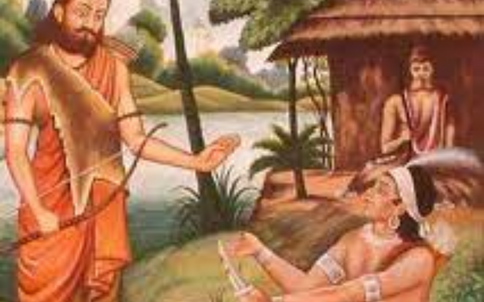Indian History has been misinterpreted by some people with vested interests. For example, even in the Mahabharata, a sacred epic of India, the story of Ekalavya is known to most people only as that of a great archer who was made to cut off his thumb as he was a tribal. Ekalavya shot a bunch of arrows into the mouth of a barking dog to silence it when he was about to talk to Drona. The skill he possessed was such that the arrows prevented the dog from barking but did not damage the parts of its mouth. The arrows were like the guided missiles of the present day which hit the target with precision. The fact that Ekalvya is son of a tribal king who is also the Chief of the Army of demon king Jarasandha, of Magadha, is conveniently hidden. Thus a tribal prince is presented as a pitiable tribal to make us believe that a tribal was exploited by upper class people.
Indian society is often blamed of inequality between castes and varnas. Indian epic, the Ramayana, is written by Valmiki, a tribal who turned into a sage. The Mahabharata, another epic, is written by Vyasa son of a fisherwoman. He is considered next only to God. Many sages and holy men, who are highly respected by Hindus, are not from so called upper castes. There are innumerable examples in ancient India to show that a man was not considered low or high based on caste or religion. Megastanis, an ancient traveller from Greece, who visited India during the period of King Chandra Gupta Maurya, recorded that in India all people are treated equal. Actually the word caste is of Portugese origin. A British Census Commissioner in 1931 recorded that Indians are of many castes.
Panchayat, the local self governing system, is another good example to show the harmonious functioning of Indian society. It is not known to many that the five members in the ancient Panchayats were chosen one each from the four varnas viz, Brahmin, Kshatriya, Vysya, Sudra and a tribal from the surrounding areas of the village. It was true democracy with representatives from all sections of the people.
Another charge on Indian culture is that we did not permit our women to get educated. Gargi and Maitreyi are women of great learning and wisdom. They were treated as Gurus by ancient India. When Sankaracharya was touring India on foot defeating opponents of Advaita philosophy, he had discussion with Mandan Misra. Misra’s wife, Ubhaya Bharati, was the judge to decide the winner. To those who say that women were not given equal status in Indian society we may give the example of Queen Prabhavati of Gupta dynasty of the 4th Century, and many more warrior queens like Ahalya of Holkar dynasty, Lakshmi Bai of Jhansi. In fact, in Indian ethos, women are not equal to men but are more than men. All our sacred things are addressed as mother: Bharat mata, ma Ganga. We give prominence to women (mata-pita). This could be seen even in the names of gods and goddesses: Sita-Ram, Lakshmi-Narayan, Radha-Krishna.
It is necessary to know facts before judging anything.





[…] Source link […]